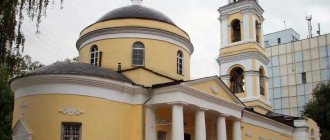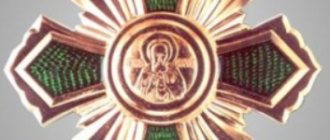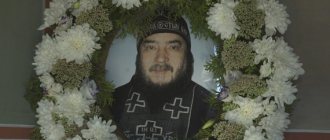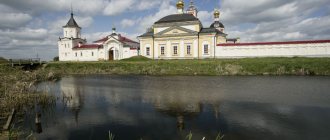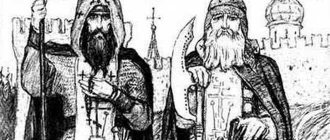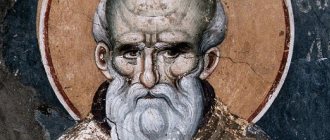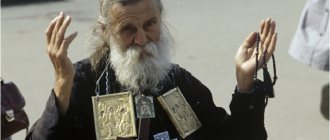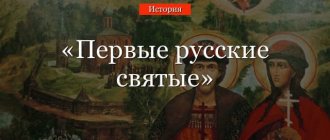Arkhangelsk diocese
Reverends Savvaty, Herman and Zosima of Solovetsky
Memory of St. Savvaty - September 27/October 10
St. Herman – July 30/August 12
in the Cathedral of Solovetsky Saints – August 9/August 22
in the Cathedral of Karelian Saints – May 21/June 3
The Monk Savvaty, the Solovetsky wonderworker, along with another saint of God, the Monk Zosima, is considered the founder of the greatest shrine of the Arkhangelsk land - the Solovetsky Transfiguration Monastery. “No information has been preserved from which city or village the Monk Savvatiy came, who his parents were, and how many years from birth he took on the monastic form” (18, 600).
What is known for certain is that, already an experienced elder monk, the Monk Savvaty labored in the famous Vologda Kirillo-Belozersk monastery, where, “working for the Lord day and night, he mortified his body with fasting, labor and perfect obedience to the abbot and brethren.” For this he enjoyed love and respect from the abbot and the monastery brethren. However, the Monk Savvaty remembered that praise in earthly life should be sought not from people, but from God. The good reputation he acquired in the Cyril Monastery weighed heavily on him; in addition, the Monk Savvaty strove with all his soul for a harsh ascetic life away from people. Therefore, with the blessing of the abbot, he left the Kirillo-Belozersk monastery. His path lay on Lake Ladoga, where on the island stood the Valaam Monastery of the Transfiguration of the Savior, founded at the end of the 9th century, where “the monks led the most austere life” (19, 3 – 4).
Arriving at Valaam, the Monk Savvaty was “joyfully received” into the ranks of the monastic brethren. Within the walls of this monastery, “imitating the laborious exploits of the monks there and constantly multiplying his labors, the ascetic spent considerable time.” At the same time, “as in the Kirillov monastery, he surpassed everyone in asceticism, so that his virtuous life became known to everyone on Valaam, for he exhausted his flesh to the extreme limits and already during his lifetime became the dwelling place of the Holy Spirit” (18, 602) . In the Valaam monastery, the monk “did not escape the glory and respect of the brethren” (19:4) and therefore again began to think about leaving for the desert, inaccessible to vain glory and human rumor.
The Lord fulfilled the desire of the Monk Savvaty. From people the ascetic learned about the existence of an uninhabited Solovetsky Island in the middle of the White Sea, which needed to be reached by sea for two days. “Listening to stories about the deserted island, the monk rejoiced in spirit and was overwhelmed by the ardent desire to settle on it for feats of silence” (18, 602). However, the Valaam abbot and the brethren did not want to let go of the elder, who was a model of virtue for the entire monastery. Therefore, Savvaty had to secretly leave Valaam. “It was seven hundred miles or more from the Valaam Monastery to the White Sea. And God’s help accompanied him, and he was protected by the action of the Holy Spirit, and he was guided by the grace of Christ to the very sea” (20, 161).
When the Monk Savvaty reached the coast of the White Sea, local residents willingly told him about Solovetsky Island, that it was suitable for living: it had fresh water, forests, and lakes where fish were found. They also talked about why no one dared to settle there. The route to Solovetsky Island lay only across the sea, was extremely dangerous and took two days. Only in calm weather, when the sea was calm, did fishermen swim up to him in boats. In winter, communication with Solovetsky Island was completely interrupted.
Hearing about the desire of the Monk Savvaty to settle on this uninhabited island, people were amazed. They asked him in bewilderment: “What will you eat or wear on the island, being at such an old age and having nothing? And how will you live alone at a far distance from people, when you are no longer able to do anything for yourself?” The monk answered them: “I have such a Lord who makes the nature of an old man young. He enriches the poor, gives the needs of the poor, clothes the naked, and with a little food satisfies the hungry to the full, just as He once fed five thousand people in the desert with five loaves of bread” (18, 604).
“Listening to the speeches of the saint, people who had reason were amazed at God’s love for mankind and the wisdom of his teaching. Others, who did not have even a good thought, mocked him and insulted him for his imaginary foolishness” (20, 161). Despite this, the Monk Savvaty firmly believed that with God’s help he would be able to endure all the hardships of desert life on an uninhabited island in the middle of the endless sea. His faith was not disgraced. The Lord helped Savvaty find a person who wanted to share the desert life with him. This man was the monk Herman, who lived at the chapel in the village of Soroka on the Vyga River. The Monk Herman was a native of Totma and a Korelian by origin (20, 161). He did not learn to read, but “his mind and heart, without school or books, were brought up in the strict rules of Christian morality and piety” (1, 34). The Monk Herman had already visited Solovetsky Island together with local fishermen. He confirmed to the Monk Savvaty everything that the local residents told about this island. After consulting with each other and praying to God, the ascetics decided to go to Solovetsky Island. Having prepared the boat, as well as some necessary supplies and things, the Monks Savvaty and Herman set sail across the White Sea, placing all their trust in the Lord. This happened in 1429 (19, 5).
By the grace of the Lord, their journey turned out to be successful. The weather was clear and the sea was calm. Having landed on the shore, the monks found a beautiful place where they decided to settle. They erected a cross and a small cell there and “began to live in the Lord in unceasing labor, prayer and singing psalms” (19:5). “The saints worked with their hands and praised the Lord with their lips, approaching Him through unceasing prayer and singing the psalms of David” (18, 605). This was the beginning of the Solovetsky Monastery.
The local residents did not like the fact that monks settled on the uninhabited island. “We are the direct heirs of this island and have the undeniable right to own it” (19, 6), they said, as if forgetting that they had previously considered the island uninhabitable. One local fisherman had a desire to live on Solovetsky Island and moved there with his family. He settled near the desert monks. It was obvious that someone had to leave these lands forever.
There is a well-known saying: “Man proposes, but God disposes.” The fisherman hoped that the monks could not stand the proximity of his family and would leave. However, it was not the monks who had to leave Solovki, but he and his family. Here's how and why it happened.
One Sunday, after prayer, the Monk Savvaty went out to cense the cross that had been erected at the time when he and Saint Herman settled on the island. Suddenly he heard the sounds of blows, screaming and crying of a woman. Savvaty considered this to be a demonic obsession. Having made the sign of the cross, he returned to his cell and told the Monk Herman about what he had heard. Saint Herman followed the noise and saw a sobbing woman, who turned out to be the wife of a fisherman. Through tears, she told the ascetic about what happened to her: “When I was going to the lake to see my husband, two bright young men met me. Having grabbed me, they beat me with rods, saying: “Get out of this place. You cannot live here, because by the will of God it is intended for the residence of monks.” After that they became invisible” (1, 20). In memory of this miracle, the mountain in the middle of Solovetsky Island was named Sekirnaya.
Having learned about what had happened, Savvaty and German thanked God, who designated Solovetsky Island as a dwelling for monks. The fisherman, hastily gathering his family, left Solovetsky Island forever; none of the local residents dared to settle on it.
Reverends Savvaty and Herman lived together on the island for several years. Then Saint Herman “sailed to the Onega River to acquire the needs of life” (1, 21). Savvaty was left completely alone. At first he was saddened by the departure of his companion, but then he began to strive even more zealously. “Deepening his mind in a constant prayerful conversation with God and turning his eyes full of tears to Him, the monk sighed day and night, wanting to renounce the body and unite with the Lord. Only the Lord knew what his stay on the island was like, what his fast was like, what his spiritual exploits were like!” (18, 606).
At the end of September 1435, the Monk Savvaty, during prayer, received news from God about the proximity of his death. He was not afraid to die, because he had an ardent “desire to be resolved and to be with Christ” (Phil. 1:23), but he wanted to prepare for death in a Christian way - by confessing and partaking of the Holy Mysteries of Christ. Having prayed to God, he left Solovetsky Island and set sail on the sea in a small boat. “Through his prayer the sea calmed down” (18, 606). Two days later, Saint Savvaty found himself on Vyga, at the very chapel where he had once met the Monk Herman. At this time, Abbot Nathanael was there, “arriving to visit Orthodox Christians.” The Monk Savvaty turned to him with a request: “I ask you, father, to wash away the sins that I confess to you, and grant me communion of the Holy Mysteries.” To these words of the elder ascetic, Abbot Nathanael replied: “God will forgive you, brother,” and, after a pause, said with tears: “Oh, if only I had your sins, reverend!” (1, 21). Anticipating his imminent death, Savvaty asked Nathanael to give him communion as soon as possible. The abbot suggested that he wait until the morning, because he still had to go to a neighboring place to give communion to the sick man. To this the Monk Savvaty answered: “Father, do not put it off until the morning - after all, we do not know whether we will breathe air until tomorrow, and even more so how can we know what will happen then” (18, 607). In the end, Nathanael fulfilled the request of Saint Sabbatius, and then went to the sick man. After communion, Elder Savvaty “prayed long and earnestly, thanking God for communion and for all His mercies, and then, entering his cell, he began to prepare for his departure from this life.”
By the inscrutable will of the Lord, the Novgorod merchant John, who found himself in Vyga on his trade business, became a witness to his righteous death. This was the last person worthy to hear the instructions of the Monk Savvaty. “He, having entered into a conversation with the merchant, taught him love of poverty, mercy and other good deeds.” The ascetic refused the gifts that the merchant offered him and invited John to stay on Vyga until the morning to “see the grace of God.” The merchant wanted to set off as quickly as possible, but a storm arose at sea and he had to stay.
The next morning, having come to Savvaty for a blessing to set off on the road, John found him already dead. The saint departed to the Lord during prayer. He was dressed in a mantle and a monastic cap. When Abbot Nathanael returned, he and John buried the body of St. Savvaty with honor. “Both of them - Nathanael and John - recalled with surprise how one taught him the Holy Mysteries and how the other was privileged to hear the dying instructions of the monk” (1, 22). Subsequently, in 1465, the relics of St. Savvaty were transported to Solovki.
The Monk Savvaty died on September 27, 1435. This day, October 10 according to the new style, became the day of remembrance of the Solovetsky Wonderworker.
Saint Savvatius laid the foundation for monastic life “in the father of the ocean-sea,” on the Solovetsky Islands. The successor of his work, who glorified this place, marked by the many years of labor and prayers of the Monk Savvaty, was another monk - the Monk Zosima. Venerable Zosima of Solovetsky
†1479
Memory – April 17/April 30
in the Cathedral of Solovetsky Saints – August 9/August 22
in the Cathedral of Karelian Saints – May 21/June 3
The birthplace of the Monk Zosima, who “was destined to found the famous Solovetsky monastery on an uninhabited island” (19, 11), was the village of Tolvui (or Shunga) (20, 147) on the shores of Lake Onega. In those days, these lands belonged to the region of Veliky Novgorod.
The parents of the future ascetic Gabriel and Varvara were peasants. They “raised their son in piety and good morals” (1:24). Young Zosima “was quiet, peace-loving, meek, retired from youthful games and occupied himself with deeds pleasing to God” (19, 12).
The parents made sure that their son knew how to read and write. Thanks to this, the youth Zosima fell in love with reading books of spiritual content, from which he “acquired pearls of reason.” Getting acquainted with the lives of the ancient desert monks, he wished with all his soul to lead the same godly ascetic life.
Wanting to devote himself to serving the Lord, the Monk Zosima “on reaching adulthood did not want to get married, he left his parents’ house, put on a black dress and settled in a deserted place” (1, 24). This deserted place was “near his house” (19, 12). Perhaps young Zosima sought to imitate the life of the 4th century Egyptian ascetic, St. Anthony the Great: at the beginning of his exploit, before leaving for the desert, this saint also lived alone near his native village, preparing for a harsher life away from people. Zosima's father had already died at that time. The mother, on the advice of her son, took monastic vows in a nearby convent (20, 147). The Monk Zosima distributed the property left over from his parents to poor and poor people.
Information about a virtuous life and monastic deeds gleaned from books seemed insufficient to Zosima. He wanted to find an experienced spiritual leader, “who would show by his own example what a young man who wants to live virtuously should learn.” The Monk Zosima constantly prayed to the Lord about this. His prayer was heard. God gave the young ascetic a mentor in monastic work. He became the associate of Saint Savvatius, monk Herman. He told the young man about deserted life on Solovetsky Island, as well as “all the details about the life and exploits of the Monk Savvaty” (19, 12). Zosima was inflamed with the desire “to be the heir of the Monk Savvatius and asked Herman to show him this deserted island and instruct him in monastic life” (1, 25). Herman, seeing the ardent desire of the pious young man, agreed. Together the ascetics set off on a sea voyage to Solovetsky Island. Arriving there, they set up a hut (“tabernacle”) and celebrated the all-night vigil in it, praying to the Lord and His Most Pure Mother to help them in their desert life.
The next morning, the Monk Zosima was granted a vision in which he was shown the future of the Solovetsky monastery. Coming out of the hut, “he saw a bright ray of light and was horrified to see such an extraordinary phenomenon. Turning his gaze to the east, he saw a vast and beautiful church and, not daring to look at it for a long time, because he was not yet accustomed to such revelations, he rushed into the bush in trepidation.” The amazed Zosima told about his vision to the Monk Herman, who revealed to his associate the mysterious meaning of the vision: “Do not be horrified, my beloved, and believe that through you, I think, the Lord wants to gather many monks here” (19, 13). Herman also told Zosima about how the angels forced the fisherman’s family to leave the island, intended by God to establish a monastic monastery on it; as we know, he was a direct witness to this miracle.
Subsequently, what was revealed in the vision of the Monk Zosima came true. However, “the hermits had to endure many trials before they saw their monastery inhabited by monks” (1, 25). Saint Zosima had to fully experience difficulties and hardships, which were sometimes associated with danger to his life.
As we remember, the connection between the hermits and the mainland was supported by the Monk Herman. He periodically went there for supplies. One day, due to bad autumn weather, he did not manage to return back in time. Zosima had to stay on a desert island completely alone for several months. At first he grieved over his loneliness, but then, casting his sorrow on the Lord, he began to “apply labor to labor, constantly remaining in fasting and prayer” (19, 14). He had to fight demons, from whose “weak insolence” he defended himself with the sign of the cross and prayer.
Here is one of the prayers with which he repelled the attacks of demons: “Eternal God, Beginningless King, Creator and Lord of every creature! Thou art the King of kings and Lord of lords, Thou art the Savior of souls and the Deliverer of those who believe in Thy name, Thou art the Hope of those who work and the Hope of those sailing on distant seas, Thou art the Teacher of Thy servants, Thou art the Lover of all good things; You are the Comforter of those who mourn, You are the joy of the saints, You are the glory of God the Father and the fulfillment of the Holy Spirit, You sit at the right hand of the Father and reign forever: I pray to You, humbly falling, hear the voice of my prayer at this hour, Most Holy King, Most Good Lord, and do not turn away your face Thy from the prayer of Thy servant, but save me from the mouth of the fierce serpent, who has dissolved his mouth and wants to devour me, protect me from the evil of the devil, so that, protected and protected by the militia of your holy angels, I will escape this destruction and receive salvation from You, my Master, in whom I believe, in whom I trust and glorify inseparably with the Father and the Holy Spirit forever” (19:15).
Another test that the Monk Zosima had to endure was hunger. However, remembering the words of the psalmist King David - “cast your worries on the Lord, and He will support you” (Ps. 54:23) - he did not feel fear for his fate, and the Lord Himself, who commanded His disciples: “do not worry and do not speak : “What should we eat?” or: “what to drink?” or: “What should you wear?”... because your Heavenly Father knows that you need all this. Seek first the Kingdom of God and His righteousness, and all this will be added to you” (Matthew 6:31-33), helped St. Zosima. “Two strangers appeared to him and handed him a supply of bread, flour and butter, saying: “Take, father, and use, and we, if the Lord commands, will come to you.” After that, the unknown guests disappeared. The Monk Zosima realized that these were angels: not a single person at that time could have reached Solovetsky Island. He hastened to thank God for His care. Thanks to the supply of food that the angels brought, Saint Zosima was able to survive the winter.
In the spring, the Monk Herman returned to Solovetsky Island. He arrived not alone, but with the fisherman Mark, who remained on the island as a novice. Subsequently, he took monastic vows. Gradually, the monastery on Solovki was populated by new people who wanted to spend monastic life in it. “Sailing to the island, they built themselves cells near the cells of Zosima and Herman and earned food through the labor of their hands” (1, 26 – 27). In the place where the Monk Zosima saw the wonderful temple, a wooden church appeared in honor of the Feast of the Transfiguration of the Lord. From her the Spaso-Preobrazhensky Solovetsky Monastery got its name.
The Monk Zosima was elected abbot of the monastery. True, this did not happen right away. Initially, Novgorod Archbishop Jonah appointed Hieromonk Pavel to this position, who, however, could not bear the difficulties of life on Solovki and left the monastery. The same happened with his successors - Theodosius and Jonah... Apparently, the Lord's will was that the Monk Zosima become the shepherd and mentor of the Solovetsky monks. At the request of the brethren of the monastery, Archbishop Jonah ordained him as a hieromonk and appointed him rector of the Transfiguration Monastery. Having visited Novgorod and received donations from the pious residents of this city in the form of money, vessels, clothes, and food supplies, Abbot Zosima returned to his monastery.
Upon his return to the monastery, the monks witnessed a wondrous sign, which indicated that the Monk Zosima was worthy of the rank of servant of God entrusted to him. When he celebrated the first Divine Liturgy in the Church of the Transfiguration, “his face was illuminated with grace, like the face of an angel, and the church was filled with a wondrous fragrance. The brethren rejoiced that the Lord had given them a mentor filled with the grace of God” (19, 17).
Under the leadership of the Monk Zosima, the monastery continued to be built. During his abbess, the relics of St. Savvaty were transported with honors to the Solovetsky Monastery and placed in a tomb behind the altar of the church in honor of the Dormition of the Most Holy Theotokos. This happened in 1465. At this solemn event, the merchant John was present, the same one to whom the Monk Savvaty gave his last instructions before his death. “The merchant John, who was at the burial of Savvaty, and with his brother Theodore, having a special love for him, painted an image of the monk and with generous alms handed it over to Abbot Zosima” (1, 29). Healings began to take place from the relics of the deceased ascetic, which testified to his holiness. Many hopeless patients, who with faith called upon the prayerful help of St. Savvaty, got rid of their ailments at his tomb.
After his elevation to the rank of abbot of the Solovetsky monastery, the Monk Zosima once again had to visit Novgorod. There he met with the famous widow of the mayor Isaac Boretsky - the proud and powerful Martha. At that time she was at the height of her power. “It is believed that in terms of the size of property, Martha Boretskaya was third after the Novgorod ruler and monasteries. Marfa Boretskaya owned about one thousand two hundred peasant farms.” She had sons from her second marriage. “In Novgorod itself, at the Nerevsky end on the Volkhov bank, there was a large courtyard with a “wonderful house” of the Boretskys” (16, 34–35). The abbot of the then small and poor Solovetsky Monastery was forced to go to this proud, fabulously rich boyar as a humble petitioner.
The reason for his trip to Novgorod was that “many of the boyar settlers, noble servants and coastal residents, having completely taken control of the fishing in the lakes, forbade fishing for food for the monastery, and the Monk Zosima and all the brethren were insulted and reviled, even boasting to disperse them.” (19, 20). The people of Martha Boretskaya especially often oppressed the monks. The Monk Zosima managed to persuade many influential Novgorodians “to prevent the monastery from being ruined.” They, as well as Archbishop Theophilus, promised to help the monastery and gave Abbot Zosima many donations. Only Marfa Posadnitsa did not even deign to listen to him. The proud noblewoman ordered her servants to drive him out of her yard as the last beggar. In his humility, the Monk Zosima patiently endured the undeserved insult, but said to his disciples: “the time will come when the inhabitants of this house will not walk around their yard, the doors of the house will be closed and will not open again: this yard will be empty.” In the end, the wayward noblewoman changed her anger to mercy and “gave the monastery ownership of the land, approving this donation with a charter” (1, 30 – 31). Moreover, she even invited Abbot Zosima to her house for dinner. They seated the guest in a place of honor and tried to treat him to something more delicious. But no matter how hard the mayor tried to treat the guest from the heart, he refused her treats and sat at the table, filled with sadness: at a cheerful feast of the Novgorod nobility, he saw a vision that horrified him. The six most important boyars, who so carefreely feasted at Martha’s, sat without heads...
Subsequently, these people were actually executed. In 1477, Grand Duke Vasily III conquered Novgorod. The boyars, whom the monk saw without heads during the feast, laid their heads on the block. The courtyard of Martha Boretskaya also fell into disrepair. Her two sons became victims of the power struggle between Novgorod and Moscow, and Martha herself, along with her little grandson Vasily, was arrested and sent into exile at the beginning of 1478, first “to Moscow, and then to Nizhny Novgorod. There she was tonsured under the name of Mary in the Conception Monastery, where she probably soon died” (16, 57). So the Lord, Who “scattered the arrogant in the thoughts of their hearts, cast down the mighty from their thrones and exalted the humble” (Luke 1:51-52), overnight crushed all the power and authority of the arrogant Novgorod noblewoman.
On April 17, 1479, at a ripe old age, the Monk Zosima departed to the Lord. He prepared for death in advance, as pious people of that time did: he prepared his own grave and made a coffin. He appointed monk Arseny as his successor. Having said goodbye to the inconsolable brethren, he bequeathed to them not to deviate from the monastery charter, and also made the following promise: “You will know that I have found grace before God when, after my departure, the monastery expands, many brethren gather, this place will flourish spiritually and in there will be no shortage of bodily needs” (1, 32). After this, he turned to the Lord with a prayer: “O Master, Lover of Mankind, grant me to stand at Your right hand on the last day, when You come in glory to judge the living and the dead and to reward each according to his deeds!” (20, 157). With this prayer on his lips, the Monk Zosima rested in the Lord.
The brethren buried the saint's body behind the altar of the Transfiguration Cathedral. “On the ninth day after his repose, he appeared to the monk Daniel and announced that, by the grace of the Lord, he had been delivered from the spirits of the air and their many snares and was numbered among the saints.” Soon miracles began to happen from his tomb. “We have repeatedly seen the saint of God during a storm ruling ships and saving them from sinking. Sometimes they saw him in church standing among the brethren. And he appeared many times at sea and on land, helping in needs and situations” (19, 24). And to this day the Monk Zosima helps those who turn to him with prayers for help and intercession.
The Monk Herman lived longer than the Monk Zosima. During the abbess of Arseny, he went to Novgorod on monastery business. There, having reached the monastery founded by the Monk Anthony the Roman, Elder Herman accepted a righteous death. The disciples were unable to bring his body to the Solovetsky monastery and therefore buried Herman at the chapel of the village of Khavronyina on the banks of the Svir River. Already under the new abbot, Abbot Isaiah, his incorruptible relics were found and transported to Solovki. In 1547, Saints Zosima and Savvaty of Solovetsky were canonized. Later, in 1692, the memory of their companion Saint Herman began to be celebrated.
On icons, Saints Zosima and Savvaty are most often depicted together. Although these ascetics never met each other, they are united by the fact that the Solovetsky Monastery was founded through their labors. The Monk Savvaty laid the foundation for it, being the first to settle on Solovetsky Island. Thanks to the Monk Zosima, the Transfiguration Monastery grew, became filled with brethren, gradually becoming the majestic northern shrine that it is to this day.
Sometimes you can find icons of Saints Zosima and Savvaty, in which they are depicted among beehives. This is due to the fact that among the people the Monk Zosima was revered as “the patron of beekeeping and the guardian of bees.” According to popular legend, he made a pilgrimage to the shrines of the East, from where he brought bees to Rus' in a hollow reed stalk. On the day of his memory, April 30 according to the new style, bees were taken to apiaries. There, having prayed to Zosima and Savvaty, “they walked around the apiary with a lit candle, sprinkled it with blessed water” (21, 165). This is associated with the appearance of beehives on some icons of the Venerables Zosima and Savvaty.
In pre-revolutionary times, the relics of St. Zosima and Savvaty were in silver tombs in the main church of the Solovetsky Monastery - Preobrazhensky, and the relics of St. Herman rested hidden in the monastery church, consecrated in his honor.
There they remained until 1920, which became fatal for most of the monasteries in the Arkhangelsk province. Only in 1992, after more than seven decades of desolation of the Solovetsky Monastery, they returned again to the walls of the revived monastery. To the list
Prayers
Troparion, tone 3
Having retired from the world and settled in the desert, / you fought a good deed, through suffering, and attention, and prayers: / from sickness and after death you exuded healing, Savvaty our father, / pray to Christ God to save our souls.
Troparion, tone 4
From your youth, reverend, having offered everything to yourself to the Lord, / and leaving all earthly things behind, / you warmly followed Christ’s footsteps, / and a bodiless cohabitant appeared and an accomplice to all the saints, the blessed Savvaty. / Therefore, we pray, Father, pray for us unceasingly to Christ God, / that He will be merciful to us on the day of judgment.
Kontakion, tone 2
You fled the rumors of life, you moved into the sea island, wise, / and took up your cross, you followed Christ in prayers, and in vigils and in fasting, exhausting your flesh with suffering. / In this way you were a blessing to the saints: / for this reason, for the sake of love, we celebrate your memory, Rev. Savvaty, / pray to Christ God unceasingly for all of us.
Kontakion, voice 3
Like an all-bright star, shining with virtues, / emitting rays of miracles on both sides, / enriching the coming souls, purpose and body, / having grace, Savvaty. / The Great Giver glorifies Himself.
What do the holy wonderworkers ask for?
Saints Savvaty and Zosima of Solovetsky are known as the patrons of beekeeping. In Rus', this occupation required moral purity and a righteous life. Therefore, only people with pious intentions could receive help from the venerable miracle workers. Bees were considered God's servants because they supply wax for candles and can only sting sinners.
People have long asked Savvaty and Zosima for bee flocks and swarms to be rich and numerous, and for honey to be sweet, aromatic and thick.
Veneration of the saints
Thirty years after the death of Savvaty, his relics were transferred to the Solovetsky Monastery, where Zosima was the abbot at that time.
The Monk Zosima was buried in 1478 behind the altar of the wooden Transfiguration Cathedral. Almost a hundred years later, the Transfiguration Cathedral was built again, this time in stone. The relics of both saints, Savvaty and Zosima, were transferred here in 1566. In 1692, St. Herman began to be venerated in the church. In 1860, his relics were kept under wraps in a church consecrated in his honor. The relics of Saints Zosima and Savvaty were transferred to the newly built Holy Trinity Cathedral, where, placed in silver shrines, they were kept until 1920. After that, until 1989, they stayed in the anti-religious museum.
In 2021, the relics of all three saints returned to the Holy Trinity Cathedral of the Solovetsky Monastery.
The days of memory of the Venerable Elder Savvaty of Solovetsky are celebrated on September 27, as well as on August 8 - according to the Julian calendar. In addition, on August 12, Christians celebrate the day of the discovery of the relics, and on August 22, the day of the Council of Solovetsky Saints.
Literature[ | ]
- The Life of our Venerable Father Savvaty, the Solovetsky Wonderworker // Lives of the Saints in Russian, set out according to the guidance of the Chetyih-Menya of St. Demetrius of Rostov: 12 books, 2 books. add. - M.: Moscow. Synod. typ., 1903-1916. — Vol. I: September, Day 27.
- Savvaty, reverend // Encyclopedic Dictionary of Brockhaus and Efron: in 86 volumes (82 volumes and 4 additional). - St. Petersburg, 1890-1907.
- Historical dictionary about Russian saints. - St. Petersburg, 1862
- Solovetsky Patericon. - M., 1895
- Akathists to Russian saints: in 2 volumes - St. Petersburg, 1995
- Melnik A.G.
Tombs of Saints Zosima and Savvaty of Solovetsky in the 15th–16th centuries. // Solovetsky Sea: historical and literary almanac / Vol. 4. - Arkhangelsk; M., 2005. - P. 49-54. - Mineeva S.V. Handwritten tradition of the Life of St. Zosima and Savvaty Solovetsky (XVI-XVIII centuries). M., 2001.
- Karelia: encyclopedia: in 3 volumes / chapter. ed. A. F. Titov. T. 3: R - Y. - Petro, 2011. - 384 p.: ill., map. — P. 58 ISBN 978-5-8430-0127-8 (vol. 3)
